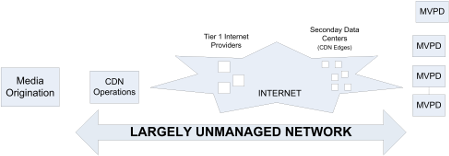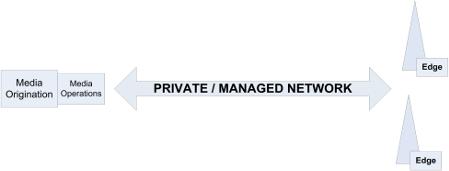The Timing of ATSC 3.0 Could Not Be Better
Consumers want the experience of streaming media everywhere, anytime. However, consumers also haven’t given up on live/linear programming, and current ratings support that notion even for Millennials. It’s just that in this case, there is no live/linear streaming currently that can be delivered with consistent high quality, in particular when the audience scales.
The streaming industry struggles when it comes to live/linear programming, especially at scale and high resolution, like 4K, for example. Part of the reason is the reliance on conventional CDN technology, and as part of that, its reliance on the internet. And why? Because this type of distribution is based largely on unmanaged networks (Fig. 1).

Fig. 1
There’s also a lack of motivation for streaming live/linear programming by the “power triangle” of programmers, multi video program distributors (MVPD) and advertisers. This triangle of constituents is resting on their multibillion dollar laurels because, 1) they have a very tight, albeit, highly-profitable triangle generating tens of billions of dollars in subscription and advertising revenue; 2) they aren’t loosening up their cable packages now or apparently any time too soon, and 3) cable programmers are currently satisfied with TV Everywhere (TVE) distribution, which has its limitations.
This triangle is also a very complicated web of rights and relationships that is too tenuous to unwind without potentially sacrificing the existing programming environment and losing control of current advertising outlets and revenues.
Yet consumers are demanding fragmentation of programming and entertainment for their own personalized consumption. They want live/linear and on-demand programming, simultaneous with internet content and applications—all synchronized; and they want it anywhere, not just in the home.
Not only is there a disconnect with today’s television/media services and consumer demand, the level of service consumers are demanding contains a “golden goblet” yet to be achieved that goes beyond streaming video: it’s streaming “television.” At such point when content providers can stream live/linear television anywhere, combined with personal internet content and targeted advertising, there lies the makings of a user experience far superior to what currently exists. It would also be superior for those content providers too, because they would be able to parlay their large broadcast audiences into increased advertising outlets based on as many demographic categories as Web-based targetability can uncover.
Get the TV Tech Newsletter
The professional video industry's #1 source for news, trends and product and tech information. Sign up below.
A NEW MVPD NETWORK
Now let’s think about the over-the-air (OTA) network, both literally and figuratively as the new over-the-top (OTT) network; an improved MVPD network that goes direct-to-consumer—physically and commercially—that doesn’t rely on the internet or a mish-mash of inconsistent third-party last-mile providers; a network that can simultaneously serve both live/linear and high resolution streaming content via OTA broadcast, in conjunction with broadband content and doesn’t rely on conventional CDN technology and instead can multicast throughout the distribution chain as needed (Fig. 2).

Fig. 2
The effective curation and distribution of content requires a direct-to-consumer relationship combined with quality of experience (QoE) analytics to enable a constant re-application of more personalized content along with targeted advertising. At that point we would have a network capable of delivering a superior consumer experience and significant advertising revenues.
BROADCASTER’S ASSETS AND ATSC 3.0
Broadcasters have large audiences and premium programming, both live/linear and on-demand. And, they have a ubiquitous footprint via the airwaves that goes direct-to-consumer—and with ATSC 3.0—could also reach mobile devices.
Furthermore, broadcasters have a simpler position in the overall business equation as they are both content provider and network provider. As a result they have a more singular relationship with advertisers and consumers. The fact that broadcasters have smaller programming offerings that don’t rely on a broader network of channels plays well into the demand for “skinny bundles” of programming where consumers prefer to assemble their own custom bouquets of entertainment.
Via ATSC 3.0, broadcasters will be able to:
- Seamlessly combine broadcast programming and broadband content;
- Facilitate comprehensive direct-to-consumer delivery;
- Consistently scale high-quality broadcast via multicast;
- Enable personalization of internet content and targeted advertising.
To meet the overall QoE demands of consumers of streaming media, ATSC 3.0 has adopted several new generation elements, the first being “dynamic adaptive streaming over HTTP” (DASH), the first international adaptive bit-rate HTTP-based streaming standard. With this, ATSC 3.0 has developed an enhanced broadcast transport method called “Real-Time Object Delivery over Unidirectional Transport” (ROUTE)/DASH for delivery of DASH-formatted content and non-real time (NRT) data. Additionally, for broadcasting, ATSC 3.0 has also adopted the MPEG Media Transport (MMT) standard, which inherits the best features of MPEG-2 transport streams (TS) and is useful in real-time streaming delivery via a unidirectional delivery network.
And in terms of quality of service (QoS)—the ability to deliver the overall experience—ATSC 3.0 empowers the broadcast network to deliver both on-demand content and linear origination from locations unimpeded to consumers, because it doesn’t rely on the internet or third-party last-mile providers. The ATSC 3.0 network can also multicast broadcast content to make the distribution service truly scalable and efficient enough to distribute 4K content.
THE IMPORTANCE OF TOWERS
So what makes ATSC 3.0 and broadcasting so powerful? A backbone of tower locations. There are tens of thousands of tower locations in the U.S. alone, and since they are distributed points of presence, they reside at the “edge” closest to the consumer; the very same “edge” that conventional CDN suppliers attempt to replicate. It’s this same “edge” where companies like Netflix locate caches for the very same reasons.
The closer the content or linear origination is to the consumer, the higher the QoE and QoS. But the economics of achieving this for all consumers by the current conventional content distribution networks provides diminishing returns; and the effects of these diminishing returns have been illustrated when streaming events at scale (Fig. 3).

Fig. 3
Geographic location of content, origination, video processing and other workflow elements closest to the consumer in a broadcast network has not been cost effective because these elements have been provided by manufacturers largely as appliances (i.e. dedicated hardware and software). However, as a result of virtualization technology, the hardware expense (CAPEX) can be minimalized and the QoE and QoS can be delivered via software and subsequently as OPEX (i.e. pay-as-you-go). This shift makes embellishment of tower locations both practical and powerful, and the beauty of virtualization is that as the market changes, so can the infrastructure.
STREAMING ‘TELEVISION’
Current conventional CDNs are built to facilitate distribution of video, which is only a single part of many when we consider the makeup of “television” programming. When you think about it, “television” is a mashup of live, linear, on-demand and advertising. Now, further combine that with blackouts and program substitution and coat it all with distribution rights of which live, linear, on-demand and yes, even advertisements, are all subject to having their own set of distribution rights. Conventional CDNs have structural limitations when supporting this complex mashup creating “television” and the streaming thereof, particularly at scale. Since conventional CDNs have been built to support individual modes of transmission—either live, linear, on-demand or interstitial, all independently— these CDNs shift large-scale traffic from one mode to the other in real-time during a “television” experience, overwhelming processing resources.
ATSC 3.0 brings a number of significant new capabilities to broadcasters; in particular, cloud transmission. Tower locations can be transformed into a new network capable of facilitating superior QoE and QoS to consumers that can’t be achieved by current conventional content distribution means. And as part of this broadcast/multicast distribution, the mashup of elements that go into “television” can be assembled by broadcasters in the very same manner they do today.
Broadcasters are in an advantageous position to achieve this “golden goblet,” and have the opportunity to significantly leapfrog the level of service currently provided by the cable networks, programmers and MVPDs. Broadcasters need to firmly evaluate the concepts of cloud services residing in tower locations, and how these can improve the QoE and QoS to the consumer, and as a result, broadcasters’ bottom line.
Broadcasters must also take into consideration their potential new roles in these new services and workflows, both in terms of just how much of the overall workflow they want to own and operate, vs. how much of this workflow they should procure as third-party OPEX.
And once the new workflows and distribution are mapped out, broadcasters need to move quickly, working with tower providers to embellish the tower locations through extension of their workflows into those facilities.
Mark M. Myslinskiof OpenVideo Consulting,is a 15-year veteran of the digital cable television industry combined with more than six years recent experience in the streaming media industry. A majority of his recent focus has been on streaming media distribution and the challenges associated with live/linear programming, both for large scale audiences and high resolution content. Much of this latter experience has been in association with new generation and hybrid content distribution networks, most recently on ATSC 3.0 and the next phase of opportunity in the broadcasting industry. Mr. Myslinski can be reached atmark_mys@comcast.net.
See moreTV Technologycoverage at ourATSC 3.0 silo.
